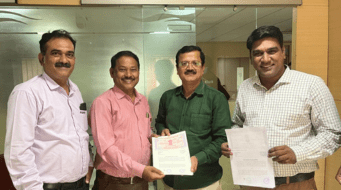by Tanmay Pisolkar
The state of Maharashtra has a wide range of rainfall patterns, ranging from 6000mm to 500mm. With 82 percent of the rural population reliant on agriculture for a living, even small changes in this diversified regional and yearly rainfall result in different crop yields. Groundwater is the major source of irrigation, covering nearly 29 lakh hectares of land. Out of total groundwater use in the state, 85% is used by agriculture services, 10% by industries, and 5% for domestic water requirements. This 5% of domestic water use comprises 80% of the rural population. The numbers clearly state that there is a tremendous dependency on groundwater in Maharashtra. The issue of groundwater depletion is becoming more severe owing to climatic changes, land-use changes, overexploitation of groundwater, unmonitored and non-sustainable use of groundwater so on so forth. Seasonal, as well as annual depletion of groundwater levels, is being highlighted at the grass-root level.
Groundwater Survey and Development Agency (GSDA) has recorded a significant downward trend in renewable groundwater resources across the country. These include 252 wells from various areas that have shown the depleting water table due to increasing pumping. Therefore, to overcome such challenges, we must mobilize the community through community participation, enhance their knowledge about the available resources, and use it judiciously.
WOTR organized a workshop for five villages in the Parner block to introduce the concept of participatory aquifer management through a 3-D model. The Parner block in the Ahmednagar district of Maharashtra is prone to water scarcity due to anthropogenic activities and climate changes. The geophysical survey and secondary data showed that these five villages share the same aquifer, namely Kalkup, Padali Kanhoor, Jamgaon, Bhandgaon, and Hivare Korda villages. Therefore these five villages must come together and sustainably manage the groundwater. An aquifer is the source of groundwater. It is a porous and permeable rock stratum that can store and transmit water. The same water is then extracted through dug wells and bore wells. And that means the extraction of water from one village will hamper wells’ potential in other villages. The increasing number of bore wells and dug wells affects groundwater levels.

Perception of participants before and after the stakeholder engagement aquifer workshop
The participants were representatives from five selected villages. Most of them were farmers with basic or no technical background related to groundwater management. The confusion in understanding surface water sources and groundwater (aquifer) was phenomenal within the participants. Though it was evident to everyone that an increase in dug wells and bore wells will not increase water availability, the ground reality reflected the opposite. Participants were unaware of the functioning and occurrence of groundwater which led to mismanagement of water. To unravel this, a two-day aquifer stakeholder engagement workshop was conducted.
During this, three-dimensional models of surface and subsurface were prepared in which it showcased all the five villages. Everyone was eager to put their opinion forward. A 3-D model comprised topographical features and generalised land use in each village was demarcated on the model. This helped in initiating a discussion on available natural resources, water, and forest. Different color codes and symbols were given to various topographic details such as, drainages, roads, wells, bore wells, check dams, farm ponds, lakes, etc. When the entire model was ready, it grabbed the participant’s attention and made them to analyze the situation. When the boundaries of each village were drawn, the participants noticed that the number of wells and bore are more in number. Participants initiated a constructive discussion by comparing and analyzing the condition and availability of their natural resources in the village.
To understand the situation below these villages’ surface, a subsurface model was prepared based on the contours generated by the geophysical survey. An aquifer, recharge area, and discharge area were delineated, which spread across these five villages. When the models were kept together, participants realised that all five villages share the same aquifer; therefore, it is necessary to come together and use water judiciously. One shared aquifer supplied by a recharge area spread across all the villages gave participants a sense of ownership towards their water sources. The understanding became more apparent when everyone agreed on participatory and inclusive efforts for holistic groundwater management.

How different games helped them to understand the importance of GW management
A couple of physical activities were organized for all the participants to understand the practicality of participatory and equitable groundwater management. First, participants were asked to circle the stack of toffees, and they were told to run toward the pile of toffees and collect as much as possible. When this exercise was repeated multiple times with different gathering arrangements, everyone was left with a different number of toffees with them. During the post-activity discussion, everyone realized how their behavior with collecting the toffees is similar to what they have been doing on the ground while extracting groundwater. This made them evaluate themselves. When asked whom should be given how many toffees, the responses were interesting; as per some, the youngest should be given maximum toffees. A few said a diabetic person shouldn’t be allowed to have any, some said toffees to be distributed as per everyone’s need.
Need is a relative term, and everyone’s needs may differ from others; therefore, just and equitable distribution and management of water need to be done. This was the crux of the workshop that was conveyed to the participants.
Way forward
The workshop aimed to disseminate knowledge and mobilise the communities from 5 villages to work in a participatory manner. However, just conveying this is not enough. This knowledge further needs to be reached to everyone in the village to ensure maximum participation. More awareness generation and mobilisation workshops need to be conducted in each village to ensure democratic and inclusive cooperation from everyone. The workshop became successful when participants agreed and acknowledged the importance of participatory aquifer-based groundwater management.






